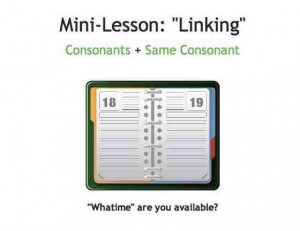 Photo credit: flickr.com/photos/perfectoinsecto/
Photo credit: flickr.com/photos/perfectoinsecto/
Watching movies is a fun way to improve your listening, but many language learners always watch movies with the subtitles on.  Although subtitles can help you understand what people are saying, there are many other ways to watch to learn English.
Here are 10 tips for watching English movies:
1.           Use subtitles… or NOT!
If you always use subtitles for movies, you’re probably reading, not listening. Try turning the subtitles OFF – maybe you don’t really need them.
2.           Rewind – watch again and again
Pick a short conversation in the video and listen to it 3 or 4 times. If you have trouble understanding what people are saying, try this:
- First, watch with the subtitles OFF
- Then, watch again with the subtitles ON
- Watch a final time with the subtitles OFF
3.           Turn off the sound
Wait… what? That’s right. TURN OFF THE SOUND. Just watch for a few minutes: Can you guess what people are saying? How do they feel? What are the relationships between people?
Watch body language, facial expressions, and try to ‘read lips’ to figure out what’s going on. Then, watch that part again with the sound on.
4.           Turn off the screen
Movies are visual, so we get a lot of information from the pictures. If you turn off the screen, you can challenge your listening skills.
5.           Repeat for sound
In the last post, we talked about ‘Tracking.’ Listen to a conversation and repeat exactly what you hear. Don’t think about meaning – just focus on sound.
6.           Repeat for meaning
At the really important parts of the movie, make sure you understand what’s happening. Repeat out loud what the actor says.  Focus on the meaning. Pause the movie – rewind if you have to – and make sure you understand before continuing.
7.           Learn new words
What did she say? If you don’t know a word, look it up. Try to guess the spelling from the sound (but if that’s really hard, look at the subtitles to find the spelling). Check your English dictionary for the meaning.
8.           Learn new phrases
How do people get things done in the movie? Make a list of phrases you hear for things like saying hello, asking for help, getting information, saying sorry, and giving orders. When the movie is over, try using these expressions in your daily life.
9.           Write it down
For a real challenge, use one short part for a dictation – write down exactly what you hear an actor say. Use the subtitles to check your sentences.
10.           Be an actor!
Imagine you are in the movie and act out one part of it. Learn a speech from one actor and pretend you are in the movie. Have fun learning the words, body language, facial expressions, and gestures and trying them out!
Practice these 10 Tips the next time you watch an English movie and your English communication will improve. Â Soon you won’t need subtitles at all!
To work with a Certified Teacher to improve your accent ContactLaura Meet in-person in Toronto or online from anywhere in the world on Skype










